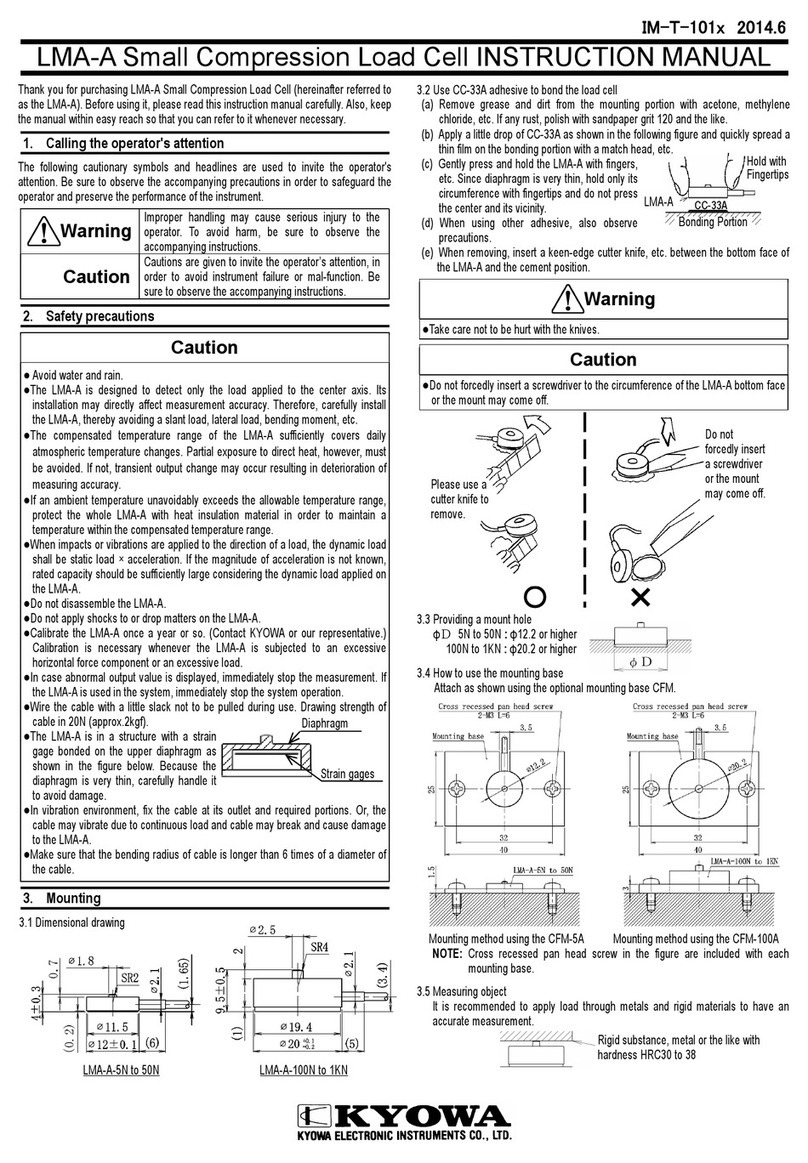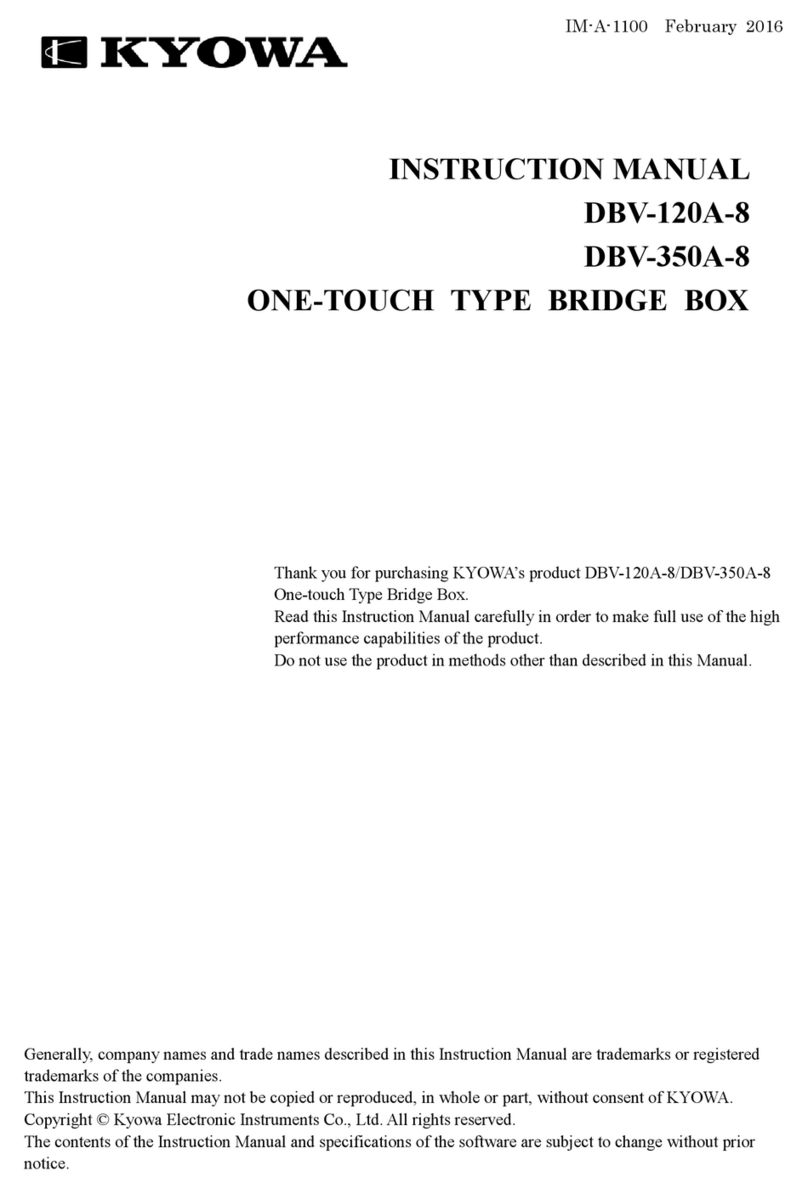
Website: www.kyowa-ei.com
6.2
Mounting object
Since the contact pressure is large, it is recommended to apply load
through metals and rigid materials to have an accurate measurement.
7. Connection
7.1
Connect the transducer to strain amplifier.
7.2
When using an NDIS connector (PRC03-12A10-7M)
, perform wiring as
illustrated below.
7.3
It is required to heat-run for 5 to 10 minutes before starting the
measurement.
7.4
A shield wire is not attached to the LMC-A. If necessary, make
grounding at the amplified indicator. At this time, if inductive noise is
generated, connect an oscilloscope to the output terminal of the
amplified indicator, and while observing the waveform presented,
perform suitable grounding. Note that grounding does not always
produce a good result.
8. Conversion
8.1
Use the calibration constant described in the Test Data Sheet to
convert a reading into a load value.
8.2
When a strain amplifier is in use, output reads in ×10-6 equivalent strain.
Find a load value corresponding to ×10-6 strain. Then, obtain a load
value through multiplication using the following equation.
Load (N) = Strain amplifier’s output (×10-6 strain)
x Calibration constant (N
/
1×10-6 strain)
8.3
When using an amplifier of other type or a recorder, first find the exact
bridge exciting voltage applied. Second, find the load value that
corresponds to 1
μ
V output voltage against 1V bridge excitation voltage.
Then, obtain the load value through multiplication using the following
equation.
Load (N) =
Bridge output voltage (μV) ×Calibration constant (N
/
1μV/V)
Bridge excitation voltage (V)
Sensitivity Decrease due to Cable Extension
If a strain gage transducer is connected to a signal conditioner, digital
indicator or strain amplifier via extension cable, we cannot ignore the
sensitivity decrease due to the extension cable resistance which lowers
the voltage applied to the transducer.
The rated output with lowered sensitivity can be obtained through the
following equation:
True value
ε
0
=(
R
)ε
i
R+(r
×
L)
Where, R
:
Transducer’s input resistance (
Ω
)
r
:
Extension cable’s reciprocating resistance (
Ω
/m)
L
:
Extension cable length (m)
ε
i
:
Rated output written in the Test data sheet
9. Maintenance and inspection
9.1
Avoid water, dust and oil from the LMC-A cable terminal.
9.2
It is impossible to exchange the cable and to overhaul.
9.3
Recommend calibrate the product once a year or so. (Contact your
KYOWA representative.)
9.4
If a suspicious initial value or reading appears, measure input
resistance, output resistance as well as insulation resistance (which
should be 100M
Ω
or higher). If abnormal resistance is found, the
cause may be failure of the sensing element.
In this case, contact your KYOWA representative for necessary
inspection.
For measurement of insulation resistance, apply a voltage lower than
50V to the insulation resistance tester.
10. Specifications
Models Rated
Capacity Natural Frequency Weight
(cable not included)
LMC-A-5KN 5kN Approx. 32kHz Approx. 5g
LMC-A-10KN 10kN Approx. 38kHz Approx. 6g
LMC-A-20KN 20kN Approx. 41kHz Approx. 10g
LMC-A-50KN 50kN Approx. 29kHz Approx. 30g
Performance
Rated Capacity See table above.
Nonlinearity Within ±0.5%RO
(20,50kN: ±1.0%RO)
Hysteresis Within ±0.5%RO
(20,50kN: ±1.0%RO)
Repeatability 0.5%RO or less
Rated Output 1.5mV/V or more
Environmental Characteristics
Safe Temperature -10 to 80
℃
Compensated Temperature 0 to 70
℃
Temperature Effect on Zero Within ±0.05%RO/
℃
Temperature Effect on Output Within ±0.05%/
℃
Electrical Characteristics
Safe Excitation 7V AC or DC
Recommended Excitation 1 to 6V AC or DC
Input Resistance 350Ω ± 2%
Output Resistance 350Ω ± 2%
Cable 4-conductor (0.035mm2) vinyl
shielded cable, 1.7mm diameter by
2m long, bared at the tip.
(Shield wire is not connected to sensor
mainframe.)
Mechanical Properties
Safe Overloads 150%
Natural Frequencies
See table above.
Material
Stainless steel
Weight See table above.(Excluding Cable)
Compliance Directive 2011/65/EU, (EU) 2015/863
(10 restricted substances) (RoHS)
[NOTE]
Products with CE Marking are compliant European RoHS Directive.
Accessories
Test Data Sheet
1
Instruction manual 1 (This book)


























